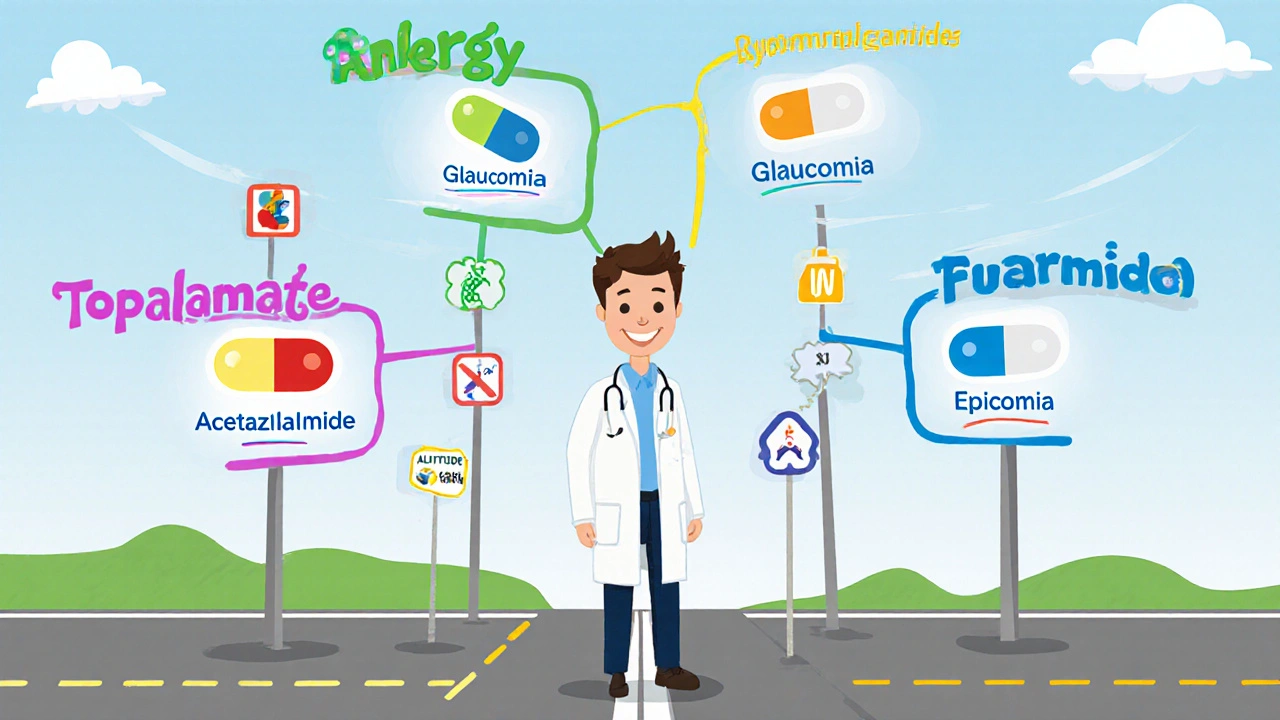Medication Selector for Carbonic Anhydrase Inhibitors
Find the Right Carbonic Anhydrase Inhibitor
This tool helps select the most appropriate carbonic anhydrase inhibitor or alternative based on your condition, allergies, and kidney function.
When a doctor prescribes a carbonic anhydrase inhibitor, most patients recognize the brand name Diamox (Acetazolamide). But it’s not the only option on the shelf. From eye‑drop formulations to other oral agents, several drugs can tackle the same conditions-glaucoma, altitude sickness, epilepsy, and fluid overload-each with its own pros and cons.
Key Takeaways
- Acetazolamide remains the go‑to oral carbonic anhydrase inhibitor for rapid altitude‑related symptom relief.
- Topical alternatives like Dorzolamide are preferred for chronic glaucoma because they spare systemic side effects.
- For patients who can’t tolerate sulfonamides, Topiramate offers a non‑sulfonamide route to carbonic anhydrase inhibition.
- Loop and thiazide diuretics (Furosemide, Hydrochlorothiazide) address fluid retention without the metabolic acidosis seen with acetazolamide.
- Choosing the right drug hinges on the target condition, renal function, and the patient’s allergy profile.
What Is Acetazolamide?
Acetazolamide is a sulfonamide‑derived carbonic anhydrase inhibitor (CAI) that reduces bicarbonate reabsorption in the proximal tubule. By promoting a mild metabolic acidosis, it increases ventilation, lowers intra‑ocular pressure, and reduces cerebrospinal fluid production.
How Acetazolamide Works
The drug binds to the zinc ion at the active site of carbonic anhydrase, preventing the enzyme from converting carbon dioxide and water into bicarbonate and protons. The downstream effects differ by organ:
- Kidney: Less bicarbonate is reclaimed, leading to alkaline urine and a mild systemic acidosis.
- Eye: Decreased aqueous humor formation lowers intra‑ocular pressure, useful in open‑angle glaucoma.
- Brain: Reduced cerebrospinal fluid volume helps control intracranial hypertension.
Primary Indications for Acetazolamide
Doctors turn to acetazolamide for four main reasons:
- Altitude sickness: Rapid prophylaxis or treatment for acute mountain sickness (AMS) and high‑altitude cerebral edema (HACE).
- Glaucoma: Short‑term adjunct to lower eye pressure before surgery or laser treatment.
- Epilepsy: Adjunctive therapy for refractory seizures, particularly absence seizures.
- Edema: Treatment of fluid overload in congestive heart failure or chronic obstructive pulmonary disease when other diuretics are insufficient.

Typical Dosage and Administration
Dosage varies by indication:
- Altitude sickness: 250mg-500mg orally every 12hours, started 1day before ascent.
- Glaucoma: 250mg orally 2times per day, or as a 2% eye‑drop solution (see dorzolamide).
- Epilepsy: 250mg-1g daily, divided into 2-3 doses.
- Edema: 250mg-500mg twice daily, often combined with a loop diuretic.
Common Side Effects
Because it creates a systemic acid‑base shift, patients often notice:
- Tingling of fingers and toes (paresthesia)
- Frequent urination and low potassium (hypokalemia)
- Metallic taste
- Night vision changes, especially in glaucoma patients
- Allergic rash in sulfonamide‑sensitive individuals
Alternative Medications to Consider
If acetazolamide isn’t a fit-due to allergy, renal impairment, or contraindications-several alternatives step in. Below each drug’s profile, we note where it shines and where it falls short.
Methazolamide
Methazolamide is another oral sulfonamide CAI. It’s a bit more potent, allowing lower doses for the same effect. However, it has a higher risk of severe hepatic toxicity, so liver function monitoring is mandatory.
Dorzolamide
Available as 2% eye‑drops, Dorzolamide delivers carbonic anhydrase inhibition directly to the eye. It avoids systemic acidosis but can cause local irritation, blurred vision, and a bitter taste if the drop runs down the nasolacrimal duct.
Topiramate
While primarily an antiepileptic, Topiramate weakly inhibits carbonic anhydrase. It’s useful for patients who need seizure control without a sulfonamide. Side effects include weight loss, kidney stones, and cognitive “fog.”
Hydrochlorothiazide
As a thiazide diuretic, Hydrochlorothiazide reduces fluid retention without affecting bicarbonate. It’s often combined with a CAI for synergy in glaucoma, but alone it’s less effective for altitude‑related ventilation enhancement.
Furosemide
Loop diuretic Furosemide blocks sodium-potassium‑chloride transport in the loop of Henle. It’s powerful for rapid volume removal in heart failure, yet it does not lower intra‑ocular pressure and can cause ototoxicity at high doses.

Side‑by‑Side Comparison
| Drug | Formulation | Primary Use | Mechanism | Major Contra‑indications | Typical Dose |
|---|---|---|---|---|---|
| Acetazolamide | Oral tablets, IV | Altitude sickness, glaucoma (short‑term), epilepsy, edema | Carbonic anhydrase inhibition (systemic) | Sulfonamide allergy, severe hepatic disease, severe kidney failure | 250‑500mg PO q12h |
| Methazolamide | Oral tablets | Glaucoma, altitude sickness | Carbonic anhydrase inhibition (systemic) | Liver disease, sulfonamide allergy | 25‑50mg PO q8h |
| Dorzolamide | 2% eye‑drops | Chronic glaucoma | Topical carbonic anhydrase inhibition | Severe ocular surface disease, sulfonamide allergy | 1drop each eye BID-TID |
| Topiramate | Oral tablets | Epilepsy, migraine prophylaxis | Weak carbonic anhydrase inhibition + sodium channel blockage | Kidney stones, metabolic acidosis, sulfonamide allergy (rare) | 25‑200mg PO qD |
| Hydrochlorothiazide | Oral tablets | Hypertension, mild edema | Thiazide diuretic (NaCl reabsorption inhibition) | Severe renal impairment, sulfonamide allergy | 12.5‑50mg PO daily |
| Furosemide | Oral tablets, IV | Acute heart failure, pulmonary edema | Loop diuretic (NaK2Cl cotransporter blockade) | Severe ototoxicity risk, anuria | 20‑80mg PO q12h |
How to Choose the Right Agent
Think of drug selection as a decision tree:
- Condition focus: Need rapid ventilatory drive (altitude) → Acetazolamide. Need chronic intra‑ocular pressure control → Dorzolamide.
- Allergy profile: Sulfonamide hypersensitivity eliminates acetazolamide, methazolamide, and hydrochlorothiazide. Consider Topiramate or a non‑CAI diuretic.
- Renal function: eGFR<30mL/min/1.73m² makes acetazolamide risky; switch to loop diuretic Furosemide for volume control.
- Side‑effect tolerance: If metabolic acidosis is a concern, avoid systemic CAIs and use topical or non‑CAI agents.
Always pair drug choice with baseline labs (BMP, LFTs) and follow‑up within a week of initiation.
Practical Tips & Common Pitfalls
- Hydration matters: Acetazolamide can cause dehydration; advise patients to drink 2-3L of water daily.
- Potassium monitoring: Diuretics and CAIs deplete K⁺; supplement with oral potassium or a K‑sparing diuretic if needed.
- Timing for altitude trips: Start acetazolamide 24hours before ascent and continue for 48hours after reaching peak altitude.
- Eye‑drop technique: Apply dorzolamide, then press the inner corner of the eye for 1minute to limit systemic absorption.
- Drug interactions: Avoid concurrent use of high‑dose aspirin or NSAIDs with acetazolamide as they may increase renal toxicity.
Frequently Asked Questions
Can I take acetazolamide if I’m pregnant?
Acetazolamide is classified as pregnancyCategoryC. It should only be used when the potential benefit outweighs the risk. Always discuss with your obstetrician.
What’s the difference between acetazolamide and methazolamide?
Both are oral carbonic anhydrase inhibitors, but methazolamide is more potent and requires lower doses. However, it carries a higher risk of liver toxicity, so liver function tests are recommended.
Is there an over‑the‑counter option for altitude sickness?
No OTC drug matches the efficacy of acetazolamide for preventing AMS. Some travelers use ibuprofen for headache relief, but it does not address the underlying hypoxia.
Can dorzolamide be used for epilepsy?
Dorzolamide is formulated for ocular use only. Its systemic absorption is minimal, making it ineffective for seizure control.
How long does acetazolamide stay in the body?
The elimination half‑life averages 10‑12hours. Steady‑state levels are reached after about 2‑3days of regular dosing.
Whether you’re climbing a mountain, managing chronic glaucoma, or tweaking seizure meds, the right carbonic anhydrase inhibitor-or its alternative-can make a big difference. Use the comparison table, weigh the side‑effect profile, and tailor the choice to the patient’s unique health picture.


I’ve used Diamox a few times for short‑term altitude trips and it usually does the job.
The tablets are cheap and easy to carry.
If you have normal kidney function they’re pretty safe, just watch for that tingling feeling.
For chronic glaucoma I’d still go with the drops, but for a quick ascent Diamox is fine.
So you think Diamox is the only answer? Think again – there are better options out there!
Dorzolamide stops the eye pressure without making you pee all day!!
Stop being a sheep and read the table!!
They don’t want you to know the truth!!
The pharma giants are hiding the real power of methazolamide!!!
If you’re allergic to sulfa they’ll push you into dangerous diuretics while they smile!!
The side‑effects are just a cover for their secret agenda!!!!
Whatever, it’s just a pill.
When you stare at a mountain and feel the thin air creeping into your lungs, the body’s chemistry flips on a switch you never noticed.
Acetazolamide pulls that switch by nudging the carbonic anhydrase enzyme, turning a mild metabolic acidosis into a breathing boost.
That same mechanism, however, also spills bicarbonate into the urine, which can leave you with a metallic taste and extra trips to the bathroom.
In the eye, the same drug reduces fluid production, lowering intra‑ocular pressure, but it does so systemically, meaning the whole body feels the side‑effects.
If you’re allergic to sulfonamides, the whole strategy collapses, and you must seek alternatives that act locally or via different pathways.
Topical dorzolamide, for example, applies the inhibition right where it’s needed, sparing the lungs and kidneys but introducing its own irritation.
Topiramate offers a gentler carbonic anhydrase tweak while also blocking sodium channels, which can be a blessing for seizure patients but a curse for stone formers.
Loop and thiazide diuretics, on the other hand, bypass the enzyme entirely and simply yank water and salt out of the system.
They excel at rapid fluid removal in heart failure, yet they lack the ventilatory drive that makes altitude sickness tolerable.
Choosing a drug, therefore, is less about a single ‘best’ molecule and more about a decision tree that balances condition, comorbidities, and personal tolerance.
Ask yourself: do I need an immediate boost in ventilation, or am I managing chronic pressure over months?
Do I have good kidney function, or is my eGFR already flirting with the low‑end?
Am I prone to kidney stones, which would make topiramate a risky gamble?
And finally, what does my insurance cover, because a $200 bottle of drops can feel like a betrayal compared to a $5 tablet.
In the end, the ‘right’ choice is the one that aligns with your physiological needs and your lifestyle, not just the label on the box.
Stay curious, read the fine print, and don’t let a single brand dictate your health journey 😊.
Great breakdown! I especially appreciate the part about kidney function – it’s something many overlook!!!
You’ve mapped the decision tree nicely; remember to also consider patient preferences and cost factors when you walk them through the options. It’s always good to have a few alternatives ready so the conversation stays flexible.
Totally agree – keep it simple and real for the patients.